Environmental Weeds: Native Invaders and Eager Exotics
We see them on the roadsides: vigorous, long-flowering, hardy and a splash of colour against the grey-green foliage of the native species. They are weeds and it is their hardiness that makes them such a threat to endemic species. Environmental weeds invade native ecosystems and adversely affect indigenous flora and fauna. There are now more foreign plants in Australia than native ones: about 27,500 introduced plant species have made their way into the country, compared with 24,000 native species. Around ten per cent of the ‘invaders’ have become 'naturalised’.
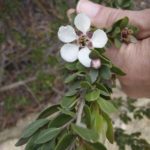 Environmental weeds were introduced as ornamental species for domestic gardens. They are survivors as they have relatively few natural diseases, insects or pests to control their populations, and can out-compete native species. Disturbed sites are havens for weed species as many thrive in poor soils and then smother existing native species. They can have significant health, economic, environmental and social impacts (Ragweed, Gorse, Rubber Vine and Salvinia, respectively). They also have larger environmental impacts such as degradation of water quality and increased risk of fire, loss of ecotourism opportunities, the costs associated with control, impacts on recreational activities and the landscape, and the reduction of biodiversity.
Environmental weeds were introduced as ornamental species for domestic gardens. They are survivors as they have relatively few natural diseases, insects or pests to control their populations, and can out-compete native species. Disturbed sites are havens for weed species as many thrive in poor soils and then smother existing native species. They can have significant health, economic, environmental and social impacts (Ragweed, Gorse, Rubber Vine and Salvinia, respectively). They also have larger environmental impacts such as degradation of water quality and increased risk of fire, loss of ecotourism opportunities, the costs associated with control, impacts on recreational activities and the landscape, and the reduction of biodiversity.
Indigenous weeds
Weed scientist, Dr. Richard Groves from CSIRO and the Weeds Cooperative Research Centre (Weeds CRC) describes the difficulty in determining the difference between ‘native’ and ‘indigenous’ or ‘endemic’ plants. “The Oxford Dictionary defines 'native' as the place or country in which you were born, and 'indigenous' as native to the soil region etc. A plant may be indigenous to a wet gully and native to SE Australia, or indigenous to the Dandenong Ranges and native to Australia", notes Dr. Groves1. The point at which an invasive indigenous plant starts becoming a weed is often difficult to define, and often too late.
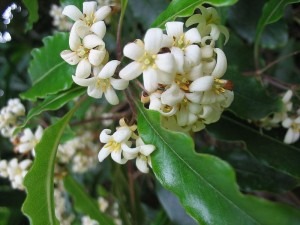
Fluctuations in indigenous populations (generally due to human interference) make the issue even more complex. The lack of bushfires in Wilsons Promontory National Park, for example, has led to Leptospermum laevigatum (Coastal Tea Tree) rapidly overtaking endemic plant communities. Pittosporum undulatum (Native Daphne) is another example of a native species literally destroying the ecosystem of bushland remnants west of Westernport Bay in Victoria. It is planted widely as an ornamental tree, and animals and birds readily disperse its fruits; it is also highly adaptable and more moderate and changing fire regimes have allowed its growth to continue – previous and hotter burns would have destroyed it. This adaptability means it successfully outcompetes other species, through shading, depletion of soil moisture and nutrients, and loss of habitat for animals. A list of top twenty weedy Australian native plants in Victoria compiled by Geoff Carr of Ecology Australia includes three Hakea species, eight wattles and three Melaleuca species.
About 200 species in Victoria have ‘naturalised’ outside their native range. A much cited example is the Cootamundra Wattle Acacia baileyana, which competes with native shrubs, small trees and ground flora, and impedes their regeneration. Not only is it a serious threat in an extraordinarily broad range of environments, it is also reportedly hybridizing with at least six other Australian wattles. This threatens the integrity of native wattle populations through genetic pollution, particularly when two of these species (Acacia decurrens and Acacia dealbata) are also environmental weeds outside their native ranges.
Government legislation on weeds
The Australian Government maintains national weeds lists, the nature of the weeds, and the resulting national actions required, determine on which lists a species may appear (see www.environment.gov.au/biodiversity/invasive/weeds/index.html). These lists and the recommended actions against specific weeds are vital guides for gardeners, nursery owners and propagators, plant importers and landscape industry, as is the social awareness that comes with purchasing, specifying or propagating a plant that may exact heavy costs in the future.
For the home gardener, ‘Grow Me Instead’ (GMI) is an initiative of the Nursery and Garden Industry Australia. Funding from the Australian Government has enabled the publication of Grow Me Instead ™ guides for each state and territory. These guides identify offenders and list several non-invasive alternatives for each, and are one valuable element of this integrated and multidisciplinary approach. Plant nurseries generally take care when supplying stock that might be on Declared Weed lists – take care however when purchasing at markets or online as many declared weeds are still propagated.
Plants to avoid
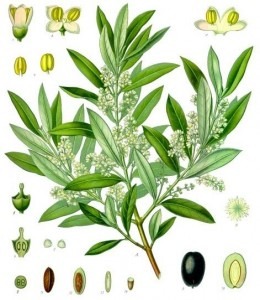
In Queensland, plants that are still available (yet listed as Class 1, 2 and 3 Pest Plants) include:
Gleditsia spp. (Honey Locust) (Class 1 – ‘potential to become very serious pest’)
Thunbergia grandiflora (Bengal Clock Vine) (Class 2 – ‘already spread over substantial areas’)
Hedychium gardnerianum (Kahili Ginger) and Hedychium coronarium (White Ginger) (Class 3 – ‘commonly established’)
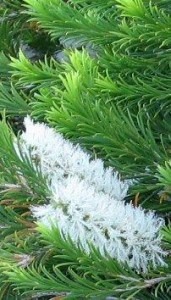
In NSW, seek substitutes for pest species such as:
Acacia baileyana,
Acacia podalyriifolia
Olea europaea ssp. Europaea
In Victoria avoid:
Acacia baileyana
Acacia saligna (Golden Wreath Wattle)
Melaleuca armillaris spp. armillaris (Bracelet Honey Myrtle).
Article and photographs by Dr. Catriona McLeod who is a writer, environmental & cultural consultant, horticulturalist and designer based in Tasmania. With a PhD in green design, she has taught design theory and principles, landscape architecture, ecology, horticulture and sustainable practices at the University of Tasmania. She is a passionate advocate of wild places and the preservation of threatened environments and species and is, of course, an avid and ever-learning gardener. www.catrionamcleod.com
References
1.Weed Society of Victoria. Can Australian Native Plants be Weeds? How big is the problem? http://www.wsvic.org.au/node/27
Non-invasive Alternatives to Weedy Plant Species
Weeds (invasive plant species) reduce biodiversity as well as having other have significant impacts such as loss of habitat, increased fire risk and the costs associated with control. So what can we do about them? Is it enough to rely on governments through environmental legislation to control or eradicate them? Or can actions of home gardeners contribute to protecting natural areas?
Environmental legislation
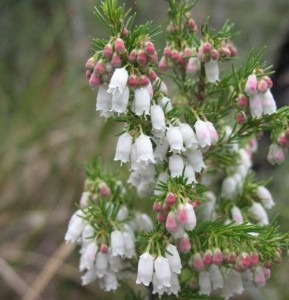
The Australian Government’s central piece of environmental legislation is the Environment Protection and BiodiversityConservation Act 1999 (the EPBC Act). This Act provides a ‘legal framework to protect and manage nationally and internationally important flora, fauna, ecological communities and heritage places - defined in the EPBC Act as matters of national environmental significance’. Laws and regulations relating to weed control exist at the Australian and state and territory government levels. Local governments also usually list weed species in the area and will avoid using them in their parks and reserves. However, it is the responsibility of every land manager or individual to be aware of legislation that may impact upon them, and to act in accordance with the respective legislation.
Spanish Heath
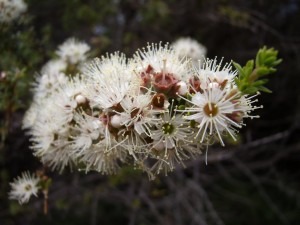
In Tasmania, Erica lusitanica (Spanish Heath), for example, is a Declared Agricultural and Environmental Weed under the Tasmanian Weed Management Act 1999. In native bushland communities, dense infestations of E. lusitanica can displace all native species, and it is highly combustible. The importation, sale and distribution of Spanish heath are prohibited in Tasmania, although I recently saw a stallholder attempting to sell bunches of the flowering stems at a rural market. The local council distributes brochures warning landholders to cut back the weed before flowering, after which millions of tiny seeds are produced and dispersed by poorly-timed slashing, livestock, farming practices, gravity, wind and water. One of its native alternatives, the shyer but showier pink Epacris impressa (Common Heath), is important for re-vegetation programs and provides nectar for honey-eating birds. Calytrix tetragona (Common Fringemyrtle) is also endemic to the coastal heathlands and is a hardy substitute for E. lusitanica in the garden,or in bush revegetation.
Alternatives to weeds
Some of the more ‘aggressive’ Tasmanian east coast environmental weeds and in Victoria can be replaced or controlled by using other species. The Aeonium species (pictured in banner above), although vigorous exotics, provide nectar for birds such as the New Holland Honeyeaters, so deadheading after flowering is finished and disposing of vegetative waste sensibly will curtail their spread.
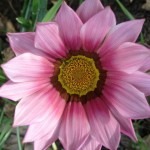
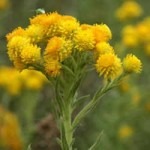
Patches of bright Gazania sp. line the coastal roads; however, it is heartening to see small colonies of Chrysosephalum apiculatum and Stylidium dilatatum re-establishing in the same areas. There are also now sterile varieties of Gazania available commercially and these include G. splendens ‘Montezuma’, ‘Sunset Jane’, ‘Sahara’, ‘Sun About’ and ‘Avalon’.
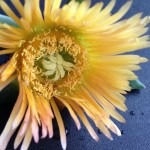
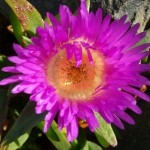
The pale lemon, maturing to pink, flowers of Carpobrotus edulis (Sour or Hottentot Fig) are no match for the beautiful and brilliant pink of the native C. rossii (Karkalla). Not yet declared or considered noxious in Australia by any state government authorities, C. edulis is naturalised in eastern and southern coastal areas of Australia. While it is still only deemed an environmental weed, it has the potential to form vast mono-specific zones, and compete with existing, threatened or endangered plant species for nutrients, water, light and space, thereby lowering biodiversity, as has happened along the Mediterranean and Californian coastlines.
Dealing with an existing weed: Agapanthus spp.
Agapanthus praecox subspecies orientalis is a weed problem in many states because of its hardiness and drought resistance. In the Blue Mountains, for example, rock ledges are congested with thick clumps; the dense, intertwined roots displace all other vegetation and smother native groundcovers. This in turn inhibits seed germination and the regeneration of trees and shrubs, and eliminates habitats for native fauna. Although Agapanthus is actively promoted as a fire-resistant plant for residential gardens in fire-prone areas it could also have an impact on fire frequency in native vegetation, as its presence makes infested bush difficult to burn.
There has been considerable effort put into producing sterile Agapanthus varieties by the nursery industry. This has resulted in Agapanthus orientalis 'PMN06' PBR ‘Queen Mum’™ Agapanthus ‘Snowball’ (dwarf white), Agapanthus hybrid ‘Back in Black’, ‘Little Boy Blue’ (dwarf blue) and Agapanthus ‘Agapetite’ (an ‘ultra-miniature’ white). However, Dianella tasmanica (Blue Flax Lily) is a more than worthy native substitute as it provides food for native animals and birds, as does the more delicate, but equally hardy, Bulbine bulbosa.
Dealing with a potential weed: Buddleia davidii
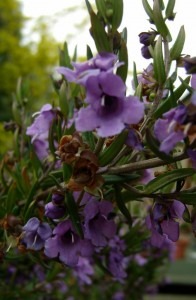
Buddleia davidii (Butterfly Bush) is another widely naturalised weed in parts of eastern New South Wales, in many parts of Victoria, in Tasmania and in south-eastern and southern South Australia, and is currently becoming naturalised in the cooler parts of south-eastern Queensland. It is difficult to control and can produce seeds during its first year; seeds are then viable three to five years. Its dense growth also starves native seedlings of sunlight. Although B. davidii has not yet reached its full potential as an invasive species in Australia, it represents a threat to many vegetation communities including damp sclerophyll forests and, in riparian areas, its shallow root system can result in the erosion of banks during flooding. Modern cultivars of B. davidii have significantly reduced fertility and are non-invasive. B. ‘Spring Promise’ and B. ‘Wattle Bird’ are Australia-raised, non-invasive varieties. Native substitutes, which are butterfly attractive, include the Prostanthera species (Native Mint Bushes), Grevillea species and hybrids, and Callistemon species and hybrids.
Levels of responsibility
In Tasmania, councils are responsible for controlling weeds on their own property but are not responsible for weed management on all property. Under the Weed Management Act 1999, all landholders must take an active part in controlling or eradicating weeds on their property.
The National Weeds Strategy and state weed management plans note that weed management is an essential part of the sustainable management of natural resources and the environment, and it requires an integrated, multidisciplinary approach.
Article and photographs by Dr. Catriona McLeod who is a writer, environmental & cultural consultant, horticulturalist and designer based in Tasmania. With a PhD in green design, she has taught design theory and principles, landscape architecture, ecology, horticulture and sustainable practices at the University of Tasmania. She is a passionate advocate of wild places and the preservation of threatened environments and species and is, of course, an avid and ever-learning gardener. www.catrionamcleod.com


